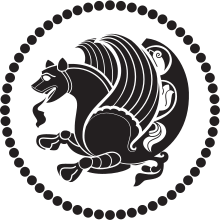 Simurgh as the royal emblem of the Sassanian Empire[1] | |
| Grouping | Mythical creature |
|---|---|
| Folklore | Persian mythology |
| Country | Ancient Iran |
The simurgh (/sɪˈmɜːrɡ/; Persian: سیمرغ, also spelled senmurv, simorgh, simorg, simurg, simoorg, simorq or simourv) is a benevolent bird in Persian mythology and literature. It bears some similarities with mythological birds from different origins, such as the phoenix (Persian: ققنوس quqnūs) and the humā (Persian: هما).[2] The figure can be found in all periods of Iranian art and literature and is also evident in the iconography of Georgia,[3] medieval Armenia,[4] the Eastern Roman Empire,[5] and other regions that were within the realm of Persian cultural influence.
- ^ Zhivkov, Boris (2015). Khazaria in the Ninth and Tenth Centuries. Brill. p. 78. ISBN 978-9004294486.
- ^ Juan Eduardo Cirlot, A Dictionary of Symbols, Courier Dover Publications, 2002, p. 253
- ^ For example, on the wall of Samtavisi Cathedral
- ^ For example, fresco depiction of simurghs inside medallions (evoking motifs found on Sassanid textiles) in the church of Tigran Honents at Ani. P Donabedian and J. M. Thierry, Armenian Art, New York, 1979, p. 488.
- ^ For example, a row of simurghs are depicted inside the "Ağaçaltı" church in the Ihlara gorge. Thierry, N. and M., Nouvelles églises rupestres de Cappadoce, Paris, 1963, pp. 84–85.